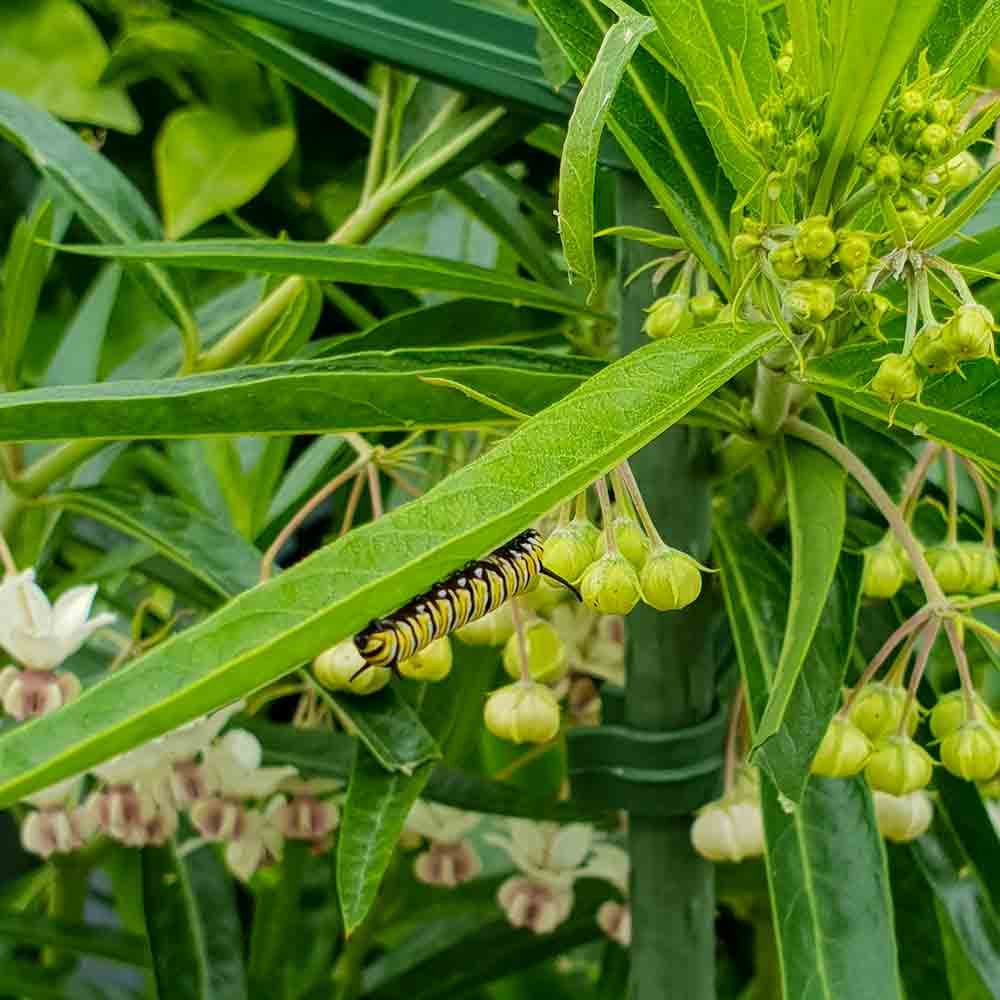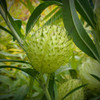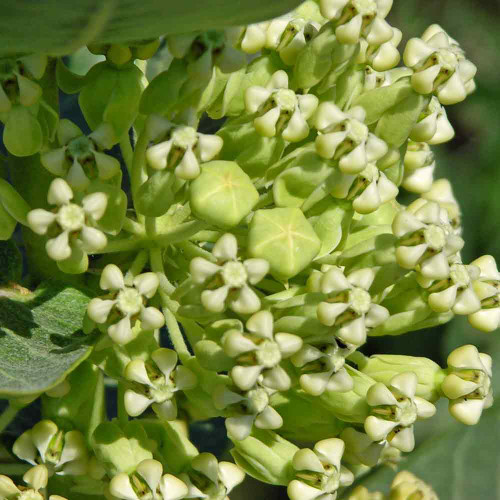Description
Giant Swan Milkweed - Monarch-Loving Eye-Catching Conversation Starter
Spotting this six-foot tall milkweed at the peak of its glory in late summer – covered with fuzzy lime-green balloon-like seed pods, each sporting soft spines – stops most people in their tracks
They quickly realize – this is unlike any milkweed they’ve ever seen.
The tree-like Giant Swan milkweed is native to tropical Africa and widely grown worldwide in botanical gardens, for several good reasons.
Due to its impressively large size, it sustains lots of hungry Monarch caterpillars from early into late season. It is also one of the few milkweeds that supply nectar for adult Monarchs, making it a Monarch magnet and a caterpillar beacon. In many areas, it is one of the last viable milkweed species still growing before fall arrives.
The species name physocarpus comes from the Greek physa meaning bladder and karpos, fruit, referring to the inflated, bladder-like fruits.
Details
The Swan plant has a slender, single-stemmed trunk has multiple hollow, gracefully arched branches supporting abundant neat, smooth textured, light green bamboo-like foliage. The big, sturdy plants make vigorous and attractive additions to flower beds and borders. Excellent for large arrangements, dried arrangements, or alone as a centerpiece. Each seed pod maintains its lime-green color and balloon-like form when dried.
Many insect species visit the abundant clusters of small, faintly vanilla-scented flowers but only wasps and hornets can pollinate them. The flowers trap a leg or mouthpart of a wasp or hornet, attaching pollen to it. Once the insect frees itself and visits another flower the process repeats, spreading fresh pollen to each flower it visits.
Giant Swan milkweed is self-incompatible, requiring pollen from a different plant to set seed, so plant several plants to ensure good pollination and seed production.
The clusters of white flowers with lavender-colored centers develop into large, pale green, papery, semi-translucent seed pods after flowering, looking like hairy, inflated balloons, swelling 2-3 inches in diameter. As they mature, they turn yellowish, often tinged with red or brown, and very gradually split open, releasing numerous smooth, flattened oval brown seeds, each with a tuft of long, silky hairs known as a pappus that carry it on the slightest breeze.
Arizona Milkweed for Monarchs has found this milkweed overwinters up to 4,000 feet elevation in Sedona & the Village of Oak Creek, known for mild winters.
History
Giant Swan milkweed is a host plant for the larva of the African monarch butterfly (Danaus chrysippus). It is widespread across South Africa, commonly seen in the Western Cape, Eastern Cape, Kwa-Zulu Natal, Mpumalanga, Gauteng, Limpopo, North West, as well as in Swaziland, Botswana, Zimbabwe, and Mozambique and northwards to Kenya. It prefers growing in grassland and bushveld, often along roadsides and in disturbed areas, from the coast to 5000 feet above sea level.
Much like their North American relatives, the caterpillars are immune to the poisonous alkaloids in milkweed and have developed the ability to store them and pass them on to the pupa and adult butterfly, which uses them to their own advantage – making them foul-tasting and poisonous to predators. Milkweed’s anti-predator strategy is passed on to the African monarch.
Its initial travels out of Africa began as lepidopterists – those who study butterflies – saw how well this plant withstood heavy feeding by hungry African monarch caterpillars, and began exporting seeds to greenhouses and conservation study sites in Europe and North America. Once the American Monarch population began sharply declining, Giant Swan milkweed was increasingly planted to feed larger populations of Monarch larvae.
Flowers
Mid to late summer
Will These Grow in My Area?
Although this milkweed is not native to North America, it has been increasingly grown to support the North American Monarch larvae, as Giant Swan milkweed is commonly seen almost covered in larvae along with adult Monarch butterflies, providing nectar for the adults along with leaves for the larvae. Due to the large size and amount of leaves, it isn’t uncommon to see one plant hatching more than 25-35 Monarch larvae into adults.
For this very reason, it is known and highly valued as a Monarch hatchery plant.
It is native to tropical Africa, having been introduced into South Africa where it has naturalized and spread widely.
It is a tender perennial in USDA Zones 8-10, and a fast-growing annual elsewhere.
Pods
Milkweed pods contain a seed floss that is used to stuff pillows or mixed with other fibers to make a cloth. It is used in Life Jackets or as a stuffing material. It is very water repellent. The floss is the mechanism for seed dispersal.
Why This Milkweed is Special
This milkweed seed is the highest quality available anywhere. It is hand-grown across central and northern Arizona, hand-harvested, hand-cleaned, and hand-packed. Over the past five years it has been test-grown in different elevations to verify the vigor and adaptability to different conditions.
Terroir Seeds is proud to be the exclusive partner in offering these unique milkweed seeds to home gardeners. The sale of each packet of milkweed seeds directly supports the continued, on-going research of Arizona Milkweeds for Monarchs organization, a dedicated volunteer citizen science research organization that is overseen by professional scientists from Northern Arizona University.
The milkweed plant (Asclepias spp.) plays a critical role in the monarch life cycle. Each spring Monarchs move across the United States, laying eggs on native milkweed, the only plant that serve as food for newly hatched monarch caterpillars. Arizona has more than 40 species of milkweed - more than 50% of the total diversity of milkweeds in the continental US - giving it the second greatest diversity of milkweeds next to Texas.
Other Names
- Giant Swan milkweed
- Swan Plant
- Balloon plant milkweed
- Oscar milkweed
- Balloon cotton-bush
- Family Jewels
Uses
Many gardeners come to value it as being a pollinator party – everything from honey bees, bumble bees, butterflies, wasps, drone flies, and even hummingbirds. One of the more frequent insect visitors is the blue mud dauber or black wasp. Though the mud daubers look ominous, they rarely show aggression during milkweed visits. They also love to visit swamp and tropical milkweed plants.
It doesn’t seem to suffer as many aphids as other milkweed varieties, with many gardeners reporting an increase in Lady Bugs.
Due to the alkaloids, the plant is extremely bitter tasting and deer learn to avoid it.
Besides being a Monarch hatchery, Swan plant is an unusual addition to mixed beds, creating a backstop to an annual flower garden, as an ornamental plant, or in large containers. The unusual spherical fruits add interest and texture, keeping their shape and color for floral arrangements.
Growing Tip
Giant Swan milkweed likes full sun and grows best in dry to medium-moist soil with good drainage. It also does well in large containers.
Start seed indoors 1-2 months before your average last frost date.
For best germination, store the dry seeds in a sealed plastic bag in the refrigerator until ready to sow. This milkweed doesn’t need cold wet stratification like most other milkweed species but soaking the seeds in water for 24 hours before planting helps jump-start the germination process.
To sow, scatter the seeds on top of the soil but do not cover them. Keep the soil consistently moist and warm during germination, since this is a tropical species.
Check soil moisture by lightly placing your fingertip on the soil. If the pad of your finger has a moist – but not wet – spot, then the soil moisture is perfect.
Ideal soil temperature is between 68-80°F and germination can take 15-30 days for sprouts to appear, so have patience. Use bottom heat, such as a seedling heat mat, old heating pad, or small electric blanket with an inexpensive digital thermometer to monitor soil temperature.
Transplant the seedlings into the garden about 2 weeks after the last expected frost date in your area - remember that this milkweed needs warm soil.
For bushier growth, cut the stems and branches back in late spring.
Harvest Tip
Collect the seed by letting the pods turn a rosy-tan color so the seed matures before starting to dry. Keep a close eye on the pods as they dry so you know when they start to open. The pods will develop a small split or crack along the seam about a day before they open, so watch for this to happen.
Don’t force the seed pods open, they will start to open when they are ready and the seed is mature.
Once the pod begins to split open, open it fully and strip the seeds from the white “silks”. If you’ve caught the pod at the right time, the seeds can be stripped from the silks right in the pod without having the silks fly all over the place.
The seeds should be brown/black and dry looking. Store in a paper bag to finish drying completely before storing in a cool, dark place.
Learn More
- Milkweed, Monarchs and Home Gardeners to the Rescue
- Milkweed Seed Germination Procedures
- Growing Milkweed for the Monarch Butterfly
- Planting A Pollinator Feast
From the soil to the seed to the food you eat - we'll help you grow your best garden!

















